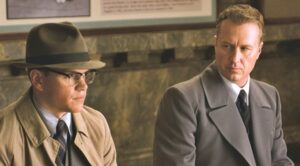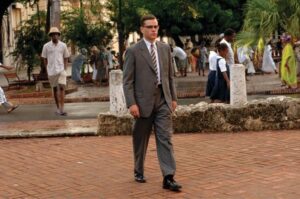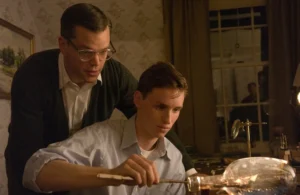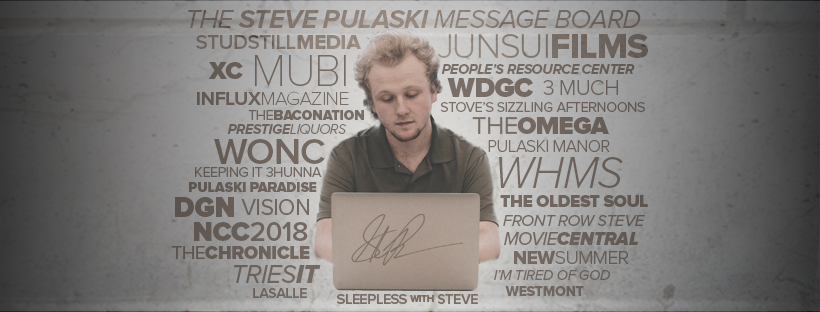Publication Date: 06-17-2025
The Good Shepherd (2006) review
Dir. Robert De Niro
By: Steve Pulaski
Rating: ★★½
Robert De Niro’s The Good Shepherd marks his second and (to date) most recent directorial effort, which is a shame given the two works with him behind the camera show the veteran actor is more than capable of carefully crafting a narratively rich story.
De Niro’s debut, A Bronx Tale, has become a cable TV staple over the past couple decades, but it’s also among my favorite mob movies. More significantly, it’s an arresting coming-of-age story about a young man (Lillo Brancato) torn between two worlds in his simultaneously violent yet vibrant New York borough. One world, governed by his father (De Niro), is defined by discipline and character; the other is the alluring world of violence and bravado anchored by a gangster (Chazz Palminteri). De Niro’s film, based on Palminteri’s play, was so well-executed both in tone and direction that it seemed, at the time, he was going to be as reliable of a director as he was an actor.

His sophomore effort didn’t come until 15 years after the release of A Bronx Tale, and unlike his debut, has a legacy that’s muted and relatively nondescript. The Good Shepherd is a novelistic epic that illustrates the rise of the Central Intelligence Agency (CIA) in America. Loosely based on the life of James Jesus Angleton, the film revolves around Edward Wilson, played by an unusually stoic Matt Damon. De Niro and screenwriter Eric Roth make the decision to have two distinctly different timelines unfold at one time. One follows Edward’s time at Yale during the late-1930s, and the other involving Edward’s time at the CIA as the agency grapples with the Bay of Pigs.
Hopscotching us between the two timelines, Edward is seen as a standout student at Yale, eventually invited to join the ultra-secret Skull and Bones Society on campus. One early scene proves to be a recurring motif, and that involves Edward mud-wrestling with his “brothers” in the society. Other members watching the combat from above start urinating on them, causing Edward to storm out and nearly ditch Skull and Bones all together. One member follows him and urges him to reconsider, for they are now “brothers.” Edward remains in the society. More than a decade later, he’ll find himself exhaustively pouring his time and energy into a country that is slowly shifting its priorities to a wealthy bastion of elites that have no sense of the American Dream. Like when he was getting pissed on by his so-called brothers, he knows it’s wrong, but he can’t help but continue forward, for a life of servitude and thread-pulling is all he knows.

While at Yale, Edward also meets and strikes up a relationship with Laura (Tammy Blanchard), a deaf student. Even during their moments of romance, Edward doesn’t let his stone-faced guard down. However, she does bring an air of humanity to an otherwise emotionless vessel of a human being, and the fact that Blanchard cuts through Damon’s icy exterior to achieve some chemistry with the star is a testament to her abilities, as well as their natural dynamic pairing. It’s too bad it’s not the core relationship in the film.
During his time in the CIA, Edward quickly ascends to a high-ranking role that allows him to mingle with folks like General Bill Sullivan (De Niro) to an FBI agent played by Alec Baldwin. It’s during this time that Edward sees the unsavory side of American wealth, and the constant political game being played by men he’d like to consider peers. These are suits who couldn’t care less about the fate, let alone fabric, of the country, but seem to have their thumb on the scale and know when to tip it.

Eventually, Edward is tapped to be a collaborator on a Soviet project known as “Ulysses” at a time when the Union is gaining increasing political power, and an American being caught with a Russian in a way deemed unbecoming could immediately lead them to being labeled an adversary (which then leads to them being remorselessly killed). Edward’s romance with Laura is also ditched when he sleeps with and impregnates Clover (Angelina Jolie), sister of one of his Skull and Bones brothers. Clover doesn’t know what she signed up for, however, for Edward’s job requires weeks and months away from home, and a level of professionalism not easily left at the door when he returns. The two raise a son, who becomes Eddie Redmayne (in only his second role), who probably can’t listen to the song “Cat’s in the Cradle” without tearing up.
There really is no good reason for Roth to tell this story in bisected form, jumping back and forth between the 40s and the 60s. Alas, he sticks to this decision to mixed results. Once the “Ulysses” plotline comes into the fold — as Roth’s script still wants to double-back to Edward’s salad days, and reignite his relationship with Laura in the present — the story becomes increasingly challenging to follow. Without a very emotive lead performance, and with the entire project being explicitly bound to a stately appearance and reticent tone, The Good Shepherd can set your mind adrift pretty easily.
There are many great moments, and one of them is when Edward recalls the suicide of his father (Timothy Hutton) to his brothers at the Skull and Bones Society. He lies naked in a coffin-like spread, and a flashback gives way to his final encounter with his dad, where he imparts wisdom about “trust” onto his boy before he takes his own life. He leaves his son a note, which Edward locks away. Fittingly, dad worked in counterintelligence, so you know his monologue about trust was as meaningful as it likely was hypocritical.

Across the board, the performances are solid, if arguably unmemorable, given the lack of emotional gravitas. Jolie isn’t give a great deal to do, and her chemistry with Damon is mostly absent (perhaps that’s the point, given Edward’s personality). Familiar faces, including Baldwin, Billy Crudup, and John Turturro, pop up in minor roles. Even returning to the big screen for the first time in eight years is Joe Pesci, playing an elderly Italian mob boss who risks deportation. He imparts perspective and even throws out a racial slur with the kind of conviction only Pesci can muster.
It took a lot for The Good Shepherd to exist, which makes it a little unfortunate that its reputation is as meager as it is. At one point, Francis Ford Coppola was attached to the project, but dropped out finding it too difficult to make the story both accessible and emotionally captivating for the audience. That alone says it a lot. De Niro’s affinity for the material is evident, and his filming techniques show he watched Martin Scorsese intently when he wasn’t acting in a scene. The Good Shepherd actually has a great deal in common with The Godfather, as they’re both epics revolving around a man who gets so wrapped up in honoring his assigned duties that he gradually loses himself to the very evils he worked to fight against. Draining that subject of some of its inherent emotion is tough to do, but it’s all in the greater good of a comprehensive story, I suppose.
Starring: Matt Damon, Angelina Jolie, Robert De Niro, Alec Baldwin, Tammy Blanchard, William Hurt, John Turturro, Billy Crudup, Eddie Redmayne, and Joe Pesci. Directed by: Robert De Niro.
About Steve Pulaski
Steve Pulaski has been reviewing movies since 2009 for a barrage of different outlets. He graduated North Central College in 2018 and currently works as an on-air radio personality. He also hosts a weekly movie podcast called "Sleepless with Steve," dedicated to film and the film industry, on his YouTube channel. In addition to writing, he's a die-hard Chicago Bears fan and has two cats, appropriately named Siskel and Ebert!


